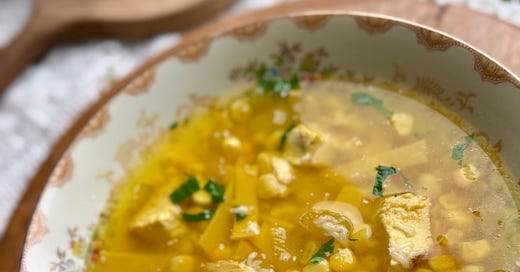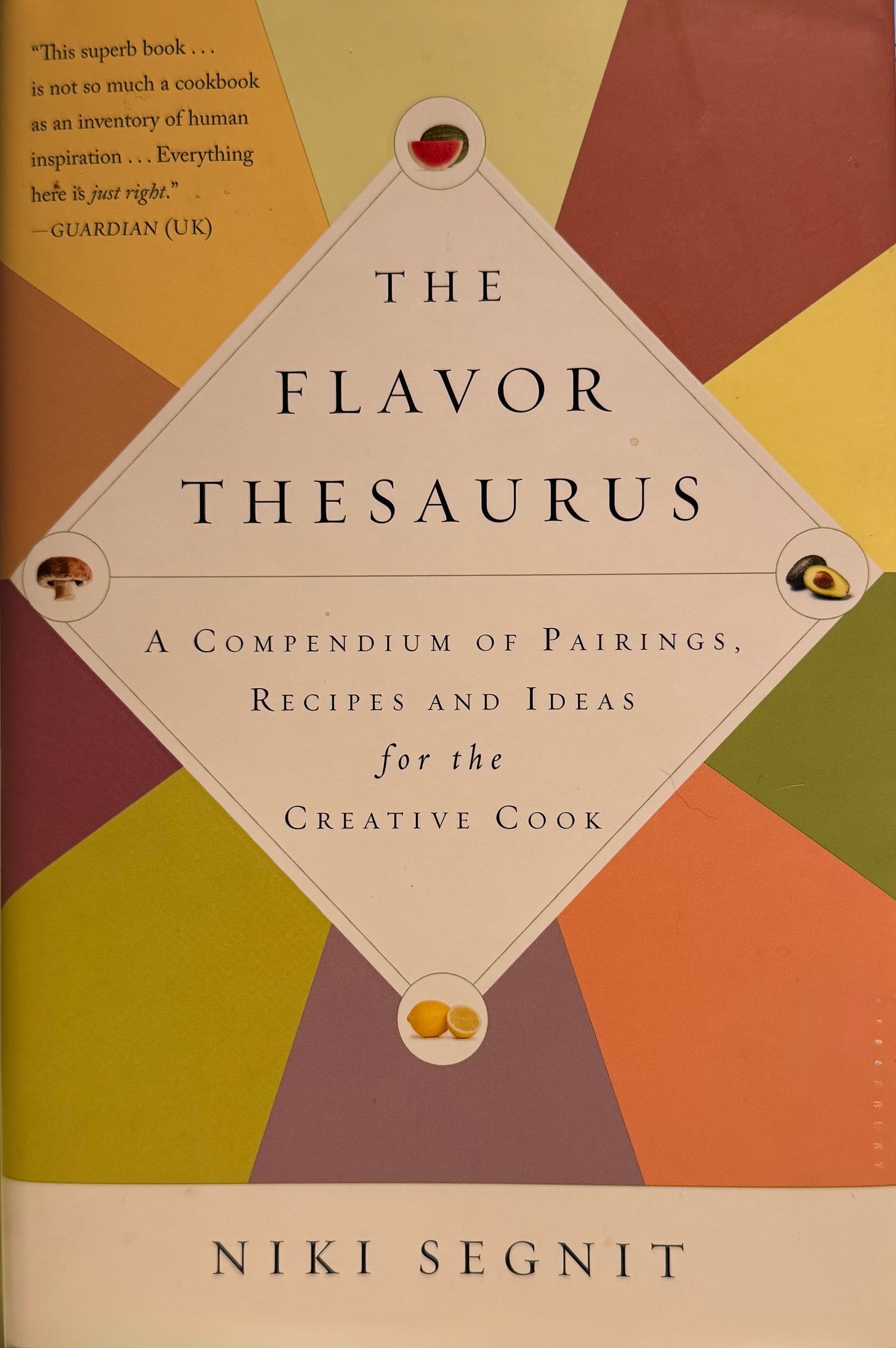On Substack and writing
and a recipe for my chicken noodle soup with a secret ingredient or two
Writing on Substack can feel like showing up to a potluck where everyone’s a James Beard nominee.
Although I’ve been writing on Substack for more that four years now, my focus was on the platform and the technology, not the community. In the past few months I’ve spent more time in this virtual kitchen, and I’m both amazed and slightly terrified. The generosity of like-minded writers—who also happen to be wildly talented—sometimes makes me second-guess my own humble offerings.
Posts are insightful, genuinely funny, inventive. The work is original and thoughtful—whether unearthing forgotten food histories at Lina’s Cookbooks Chronicles or blending memoir with menu over at Cook and Tell. Substackers are writing with voices so clear you can almost taste the words.
Being in the presence of so many distinct voices has pushed me to listen more closely for my own.
Putting new wine into old bottles
We live in an age of recipe overload. Scroll through social media, and you'll find an infinite variety of sourdough bread techniques, salads with backstories longer than novellas, and cookies reinvented more times than the wheel. For aspiring food writers, this avalanche of content can feel like both inspiration and suffocation. How can you stand out when everything feels like it’s already been done?
An idea is nothing more nor less than a new combination of old elements.
—James Webb Young, A Technique for Producing Ideas
James Webb Young was a legendary “ad man” and creative thinker from the mid-20th century, and one of the first to demystify the creative process in practical terms. Young believed that creativity isn’t magic—it’s a process of collecting, combining, letting go, and then shaping what comes back to us.
If producing ideas is about putting old things in new combinations, as Young says, then we’re probably thinking about creativity—and originality—in the wrong way.
That might be the most liberating idea a food writer—or any creator—can hear right now. It doesn’t say "invent a new cuisine." It doesn’t require us to discover an herb no one's ever tasted. It invites us to remix, reinterpret, and recontextualize. My “original” idea might be born into a thousand different people at the same moment. That doesn’t make it less real. It’s not about being first—it’s about being personal. What matters is the joy, the flavour, and the story that I bring to it.
I sometimes reach for The Flavour Thesaurus by Niki Segnit when I feel stuck—not for exact recipes, but for the reminder that creativity often begins with curiosity and play. The book is part reference, part poetry—a collection of unexpected ingredient pairings (think roast chicken and banana, beetroot and chocolate, or coriander and rhubarb) that reads like a love letter to taste. It’s a quiet nudge that inspiration doesn’t have to be loud or new—just thoughtfully combined.
In good company
Back to Substack.
Excellence in this community isn’t a closed door—it’s an invitation. It reminds us that food writing can be art, storytelling, documentation, even healing. The trick isn’t to compete with brilliance: it’s to contribute to it. With my messy drafts, my half-formed ideas, and that one killer recipe I swear by—there’s room for all of it.
So to the overwhelmed recipe creators, the burned-out bloggers, and the dreamers with too many drafts—maybe you don’t need to reinvent the wheel. Maybe you just need to cook it your way.
If you liked this post, let me know by clicking the ❤️ button. It helps spread the word about Delicious Bits and brings me joy. Thank you, dear readers and eaters!
My chicken noodle soup with a twist
serves six generously
Chicken noodle soup is a powerful touchstone for me. The smell of a warm, simmering pot of elemental ingredients brings me right back to my parents’ tiny kitchen. My widowed father would always have a pot waiting on the stove when my husband and I arrived after the four-hour drive to visit him. It was familiar, warming, full of love—the kind of welcome that warms you to the core.
My version of that bowl of goodness doesn’t stray too far from the original. Fresh or frozen corn kernels make this a bit heartier. The secret touch is a teaspoon of saffron added to the pot to bubble away as the flavours intensify. The saffron gives the broth a rich golden glow and adds warmth, depth, and a delicate floral-earthy aroma. I still finish the soup with a light sprinkle of freshly grated Parmesan, more a seasoning than a dominant flavour.
Think of it as an Italian-inflected chicken soup—somewhere between a saffron risotto and a comforting bowl of home.
Note: If you have a pasta pot with a strainer insert, it’s perfect for making the soup and straining out the chicken and vegetables before proceeding with the recipe.
Ingredients:
1 soup chicken, cut into pieces
6 cups chicken broth
1 medium yellow onion, chopped
2 medium carrots, chopped
1 large celery stalk, cut into four pieces plus ½ cup finely diced celery
Salt and freshly ground pepper to taste
1 tsp saffron threads, crushed
¾ cup fresh or frozen corn kernels
1 cup cooked chicken, cut into bite-sized pieces (leftover rotisserie chicken is especially good here)
½ cup uncooked egg noodles, broken into bite-sized pieces
1 Tbsp chopped fresh flat-leaf parsley
Combine the chicken with the broth, onion, carrot, chopped celery, 2 tsp salt, and saffron threads in a soup pot over medium heat (see note). Bring to a simmer and cook until the chicken is cooked through and tender, about 1 hour, skimming foam from the surface as needed.
Strain the saffron broth through a fine-mesh sieve into a clean pot; discard the solids. Let the chicken cool and salvage any meat for the soup, in addition to the cooked chicken you will be adding.
Add the finely diced celery, corn, and noodles to the broth. Return the soup to a simmer and cook until the noodles are tender, about 12 minutes. Add the cooked chicken and parsley; simmer for 2–3 minutes more, to heat the chicken completely. Taste and season with salt and pepper. To serve, sprinkle with a fine dusting of freshly grated Parmigiano Reggiano.







Your post makes “being creative” a little more possible & accessible. Thank you
it’s such a beautiful post Elisabeth ! Listening to your inner voice and sharing thoughts, that’s the heart of our human journey and community ! you made my week with your kind mention - i’m so happy - thank you